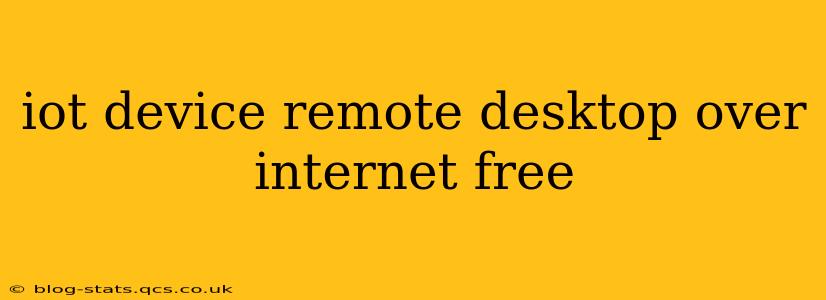The Internet of Things (IoT) has revolutionized how we interact with our devices, but managing these devices remotely can be tricky. This guide explores free methods for accessing your IoT devices using a remote desktop connection over the internet, covering security considerations and practical solutions.
What is Remote Desktop Access for IoT Devices?
Remote desktop access allows you to control your IoT devices—like a Raspberry Pi, a home server, or even some smart home hubs—from anywhere with an internet connection. Instead of physically being near the device, you can access its desktop environment and manage it as if you were sitting in front of it. This is crucial for tasks like troubleshooting, software updates, or simply monitoring your device's activity.
Is it Free to Access My IoT Device Remotely?
While the underlying protocols are free, accessing your IoT device remotely for free typically involves leveraging open-source software and careful configuration. There might be costs associated with internet access and cloud services if you choose solutions that utilize them, but the core functionality can be achieved without direct monetary payments.
How Can I Access My IoT Device Remotely for Free?
Several methods enable free remote desktop access to your IoT devices. However, the optimal method depends on your technical expertise and the specific device.
1. VNC (Virtual Network Computing): A Popular Choice
VNC is a widely used open-source protocol enabling remote desktop access. Many Linux distributions include VNC servers, making it a readily available option for Raspberry Pi and other Linux-based IoT devices. You'll need a VNC client on your computer to connect. TightVNC and RealVNC are popular choices, offering both free and paid versions (the free versions are sufficient for most home users).
Setting up VNC:
The setup process involves installing a VNC server on your IoT device and a VNC viewer on your computer. Both servers and viewers are available for various operating systems. The process involves configuring the VNC server to listen on a specific port (usually 5901), and using that port and the device's IP address to connect via the VNC client.
2. RDP (Remote Desktop Protocol): For Windows IoT Devices
If your IoT device runs Windows, RDP is the built-in solution. RDP is a Microsoft protocol, but the client is available for free on various operating systems. You'll need to enable Remote Desktop in your Windows IoT device's settings. This process usually involves setting a password and potentially configuring firewall rules. Remember to enable the appropriate firewall rules to allow incoming RDP connections.
3. SSH (Secure Shell): Command-Line Access
SSH is a secure protocol for remote command-line access. While not a full desktop environment, it's invaluable for managing your IoT device through the terminal. It's incredibly secure and widely supported across various operating systems. You'll need an SSH client (like PuTTY or the built-in SSH client in macOS/Linux) and an SSH server on your IoT device.
Security Considerations:
- Strong Passwords: Always use strong, unique passwords for your IoT devices.
- Firewall: Configure your router's firewall to allow only necessary incoming connections.
- VPN: Consider using a Virtual Private Network (VPN) to encrypt your connection and add an extra layer of security, especially if connecting over a public Wi-Fi network.
- Regular Updates: Keep your IoT device's operating system and software up-to-date to patch security vulnerabilities.
Choosing the Right Method: A Practical Approach
Selecting the right method hinges on your technical proficiency and the operating system of your IoT device. VNC offers a graphical interface, making it user-friendly for those less comfortable with the command line. RDP is ideal for Windows devices, while SSH provides a highly secure command-line experience. For beginners, VNC is often the easiest starting point.
Troubleshooting Common Issues
Connecting remotely often presents challenges. Problems may include incorrect IP addresses, firewall restrictions, or network configuration issues. Consult your device’s documentation for specific troubleshooting steps. Online forums dedicated to your device’s operating system are also helpful resources.
By following these guidelines and selecting the appropriate method, you can effectively and securely access your IoT devices remotely at no cost, unlocking new possibilities for control and management. Remember that prioritizing security is paramount when enabling remote access to any device.
